Pork belly with salted fish served in a clay pot is a homegrown Malaysian Chinese cuisine served in almost every Chinese restaurant in Malaysia. This dish is called ‘ham yue fah lam poh’ 咸鱼花腩煲 in Cantonese. The combination of pork belly with salted fish is unique.
You might find the salted fish has a pungent smell initially which is an acquired taste. Still, it develops into a deeply savory flavor that complements the pork belly perfectly after cooking.
I will start with the lists of ingredients you’ll need for this recipe, followed by the step-by-step instructions on preparing the salted fish with pork belly. Let’s dive right in!
Note: This post may contain affiliate links. Please read my privacy policy for more info. I may receive commissions for purchases made through links in this post. As an Amazon Associate, I earn from qualifying purchases.
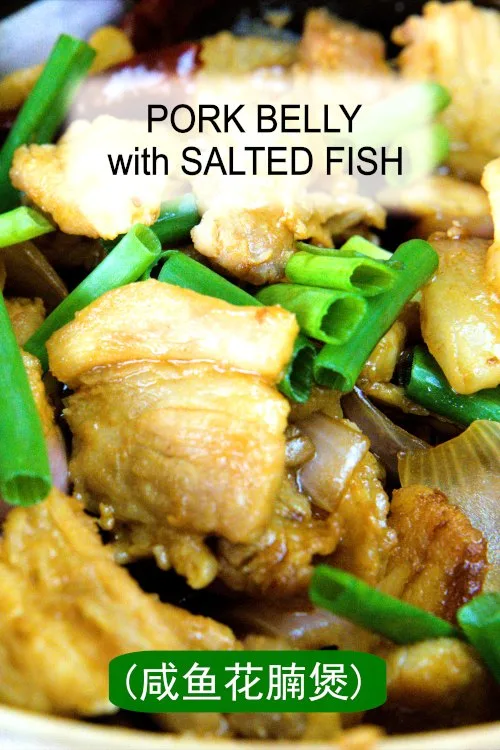
1. The ingredients required for the clay pot pork belly with salted fish
- Pork: Pork belly is the best choice for tender and flavorful meat due to its higher fat content. However, tenderloin is a good substitute if you prefer a leaner option.
- Salted fish: There are various types of salted fish. The soft type called 梅香咸鱼 is preferred as it quickly melts in the mouth and adds flavor when cooked with other ingredients.
- Besides the key ingredients, you will need aromatics such as ginger, green onions, onions, garlic, and red dry chilies.
- The typical Cantonese seasoning ingredients like light soy sauce, dark soy sauce, oyster sauce, and cornstarch will be used in the recipe.
- Finally, if you have a clay pot, it’s a plus since most Chinese restaurants serve this delicacy in a clay pot.
2. How to prepare pork belly with salted fish, step by step:
Let’s begin with the preparation steps for this dish.
- Place the pork belly in the freezer until it is half-frozen for easier slicing. After that, cut the pork belly into thin slices and transfer them to a mixing bowl. You can also consider cutting the pork into cubes.
- Add ground white pepper, vegetable oil, Chinese rice wine, and salt to marinate the pork belly. Let it rest for 20 minutes before cooking. The white pepper and salt will give the pork a base flavor; the vegetable oil helps to reduce the possibility of sticking while frying, and the wine helps to tenderize the meat.
- To prepare the salted fish, remove the bones and skin and cut it into small cubes. Salted fish has an intense flavor, so a small amount is sufficient.
- For the dry chilies, use scissors to cut them into short sections and remove the seeds. For the ginger and garlic, slice them thinly. Also, cut the green onions and separate the white and green parts. Cut the white parts into half centimeters long and the green parts into pieces 3 cm long.
Once you have prepared all the ingredients, let’s start cooking.
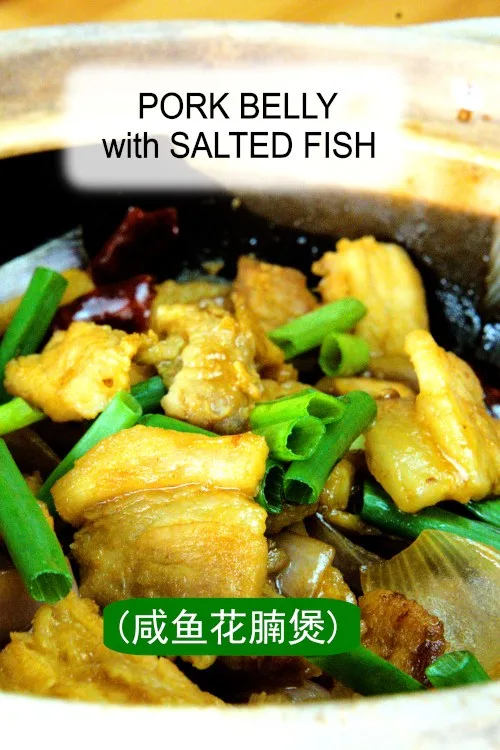
3. How to cook the pork belly:
a. Fry the pork
There are several ways to prepare pork belly. The most commonly used method in restaurants is deep-frying the pork belly slices in hot oil until they turn golden brown. This method ensures even cooking of the pork belly slices. However, it may not be the most practical option for home cooking as it requires a lot of oil. Therefore, I stir-fry the pork belly whenever I prepare it at home. This is a healthier way of cooking as it requires less oil. After frying, The oil rendered from the pork fat is used to sauté the ginger, garlic, green onions, and dried chilies.
Stir-fry the pork slices in a wok over low heat until the oil is rendered from the meat. If you’re using a non-stick pan or a well-seasoned cast iron wok, you may not need any oil to fry them. Otherwise, add some vegetable oil to prevent the pork belly from sticking. Once the pork belly has changed color and the oil has been rendered, remove it from the pan or wok, leaving the remaining oil behind.
b. Add the salted fish and other ingredients
- Add the salted fish to the remaining oil and stir-fry until fragrant. Then, remove the salted fish from the pan and leave the remaining oil behind again.
- Add ginger to the remaining oil and fry it over low heat until it becomes aromatic. Once done, add garlic, the white section of the green onions, and dry chilies to the pan. Stir-fry for half a minute.
- Return the pork slices to the pan and mix them well with the aromatic ingredients. Fry for a minute to allow the flavor to absorb into the meat.
- Season it with dark soy sauce and oyster sauce. These two ingredients will add flavor and give it a more appealing color.
- Add water to cook the pork belly for about three minutes. Also, add the salted fish to the pan and braise it with the pork belly over medium heat. Continue stirring and flipping the pork to prevent it from sticking.
- Taste it and decide if you need to adjust the flavor.
c. Transfer it to a clay pot
- Heat a clay pot on the stove.
- Next, transfer the pork belly from the pan to the clay pot. To accentuate the flavor, add a tablespoon of Shaoxing wine at this stage, which is optional.
- Make a cornstarch slurry by mixing one teaspoon of cornstarch with one tablespoon of cold water. Drizzle the cornflour mixture slowly into the pan until you are satisfied with the thickness of the gravy. You might not need to use all of the cornstarch slurry.
- Finally, garnish the dish with some green onion (spring onion) sections, and it’s ready to be served.
Claypot pork belly with salted fish is a dish commonly served in most Chinese restaurants in Malaysia, and it is also a popular dish to make at home. The combination of salted fish and pork belly is unique and is best served with plain rice, which acts as a perfect canvas to highlight this unique taste.
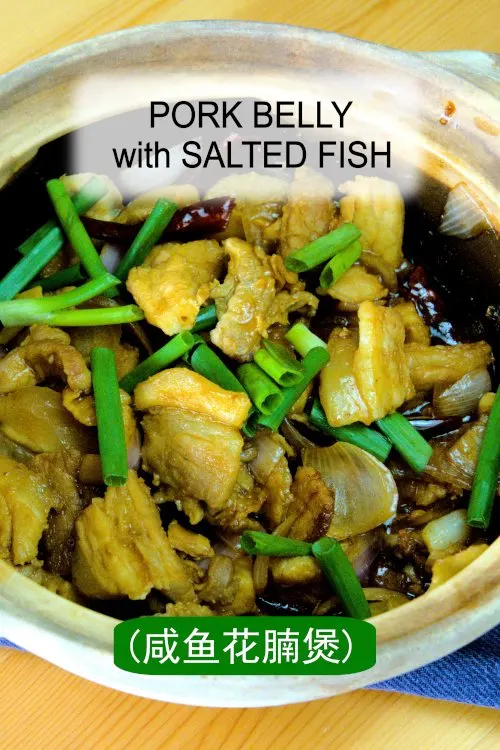
4. Other related recipes for pork belly with salted fish:
Here are some other recipes that are related to pork belly with salted fish:
- Pork belly with preserved mustard greens 梅菜扣肉 is a dish where the flavor of mustard greens is infused into the pork belly, making it exceptionally delicious.
- Fried pork belly is a traditional Hakka recipe that uses fermented beancurd and Chinese five-spice powder as the main ingredients to marinate the meat.
- Lu Rou Fan is a Taiwanese one-pot meal that consists of braised pork with thick gravy, hard-boiled egg, and some vegetables served on steamed rice.
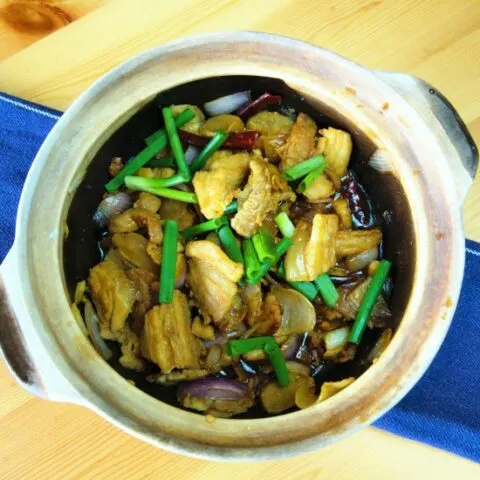
Pork belly with salted fish in clay pot recipe ( 咸鱼花腩煲)
Pork belly with salted fish is an authentic Malaysian Chinese recipe with aromatic flavor infused into every piece of meat.
Ingredients
Ingredients A
- 350g pork belly, cut thinly
- 1/8 tsp ground white pepper
- 1 tsp vegetable oil
- 1 tbsp Shaoxing wine
- 1/4 tsp salt
Ingredeints B
- 30g salted fish “Mui Hiong” 梅香咸鱼, cut into small dice
- 6 dried chilies, cut into short sections
- 3 cloves garlic, slices
- 1 inch ginger, sliced
- 2 stalk green onions, cut into short sections
- 1 medium-sized onion, cut into small chunks
Ingredients C
- 1 tsp dark soy sauce
- 1 tbsp oyster sauce
- 1/4 cup water
- 1 tbsp cornstarch to make a slurry with water
- 1 tbsp Shaoxing wine (optional)
Instructions
Preparation
- Place the pork belly in the freezer until it is half-frozen.
- Cut the pork belly into thin slices.
- Marinate it with Ingredients A for 20 minutes.
- Remove the bones and skin of the salted fish. Cut it into small cubes.
- Cut the dry chilies into short sections and remove the seeds.
- For the ginger and garlic, slice them thinly.
- Cut the green onions and separate the white and green parts. Cut the white parts into small pieces about 0.5 cm long and the green parts into 3 cm length pieces.
Cooking
- Stir-fry the pork slices in a wok. Once the pork belly has changed color and the oil has been rendered, remove it from the pan or wok, leaving the remaining oil behind.
- Add the salted fish to the remaining oil and stir-fry until fragrant. Remove the fish from the pan and again leave the remaining oil behind.
- Next, add ginger to the same pan and fry it over low heat until it becomes aromatic.
- Add garlic, the white section of the green onions, and dry chilies to the pan. Stir-fry for half a minute.
- Return the pork slices to the pan and mix them well with the aromatic ingredients. Fry for a minute.
- Season it with dark soy sauce and oyster sauce.
- Add the onion chunks and return the salted fish to the wok.
- Add water to cook the pork belly over medium heat for about three minutes.
Transfer it to a clay pot
- Heat a clay pot on the stove.
- Transfer the pork belly from the wok to the clay pot.
- Make a slurry by mixing one teaspoon of cornstarch with one tablespoon of cold water. Drizzle the cornflour mixture slowly into the pan until you are satisfied with the thickness of the gravy.
- Finally, garnish the dish with some green onions (spring onions) sanctions, and it's ready to be served.
Recommended Products
As an Amazon Associate and member of other affiliate programs, I earn from qualifying purchases.
Nutrition Information:
Yield: 3 Serving Size: 1Amount Per Serving: Calories: 548Total Fat: 28gSaturated Fat: 9gTrans Fat: 0gUnsaturated Fat: 17gCholesterol: 113mgSodium: 1296mgCarbohydrates: 37gFiber: 5gSugar: 17gProtein: 40g
This data was provided and calculated by Nutritionix on 11/28/2023

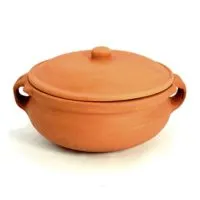

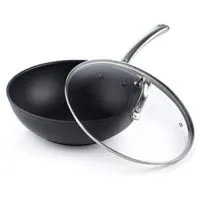
Priscilla
Thursday 4th of April 2024
Is it okay if the salted fish is replaced by fried anchovies? It gives similar strong flavor too. Secondly, can it be made spicy? Thank you
KP Kwan
Friday 5th of April 2024
Although it is not the typical way we cook, I can visualize the taste of anchovies as fantastic. I suggest adding a few dried chilies to make it spicy.
Ng Joo Hwang
Saturday 23rd of December 2023
Recommend me one of the best restaurant in KL that serves claypot belly rice with salted fish
KP Kwan
Wednesday 29th of November 2023
Hi, this is KP Kwan. Thank you for reading my recipe. Please feel free to ask any questions or leave comments. I’ll respond as soon as possible.
Amy
Tuesday 16th of July 2024
@KP Kwan, where is your restaurant, would like to visit it.
Thank you